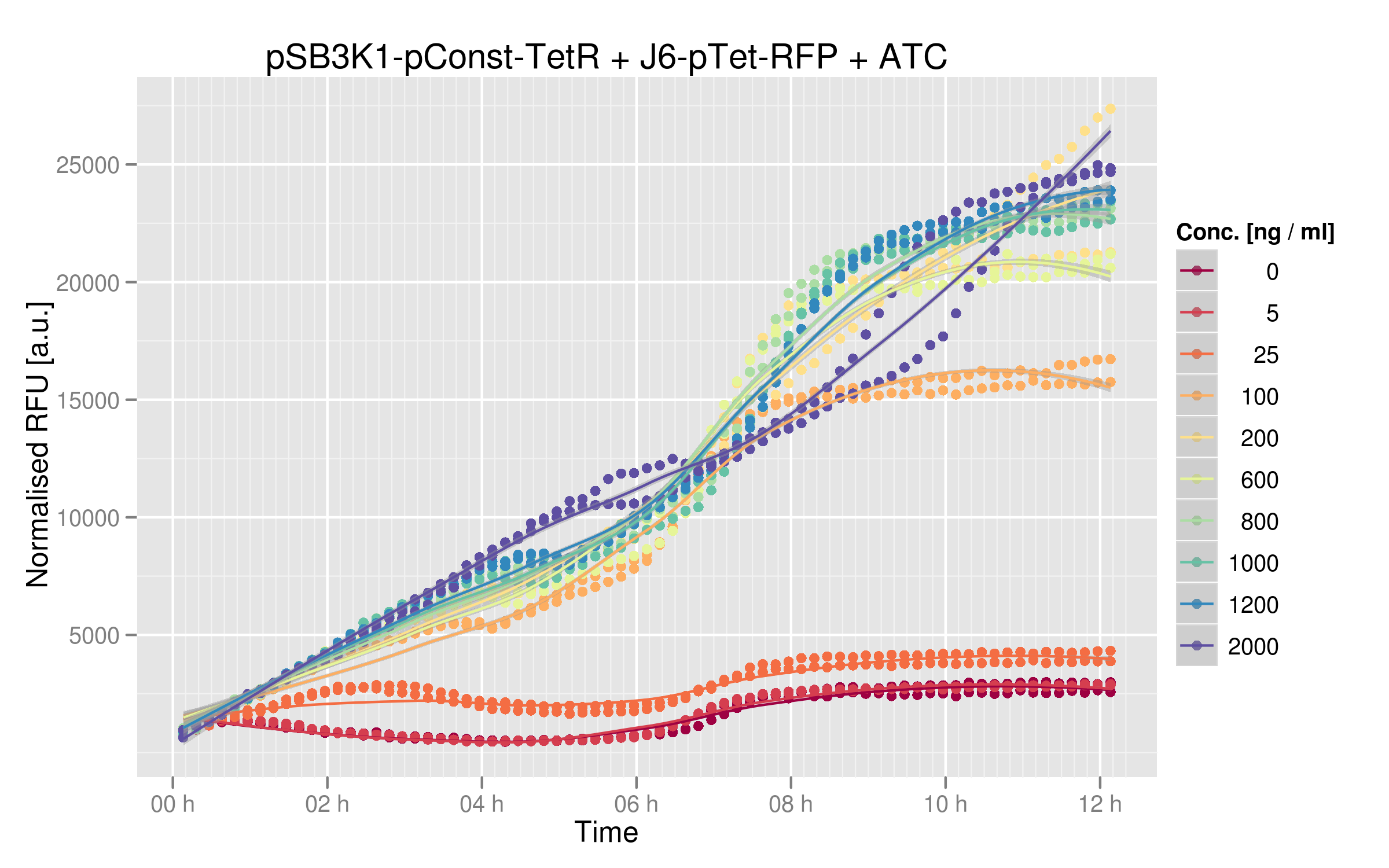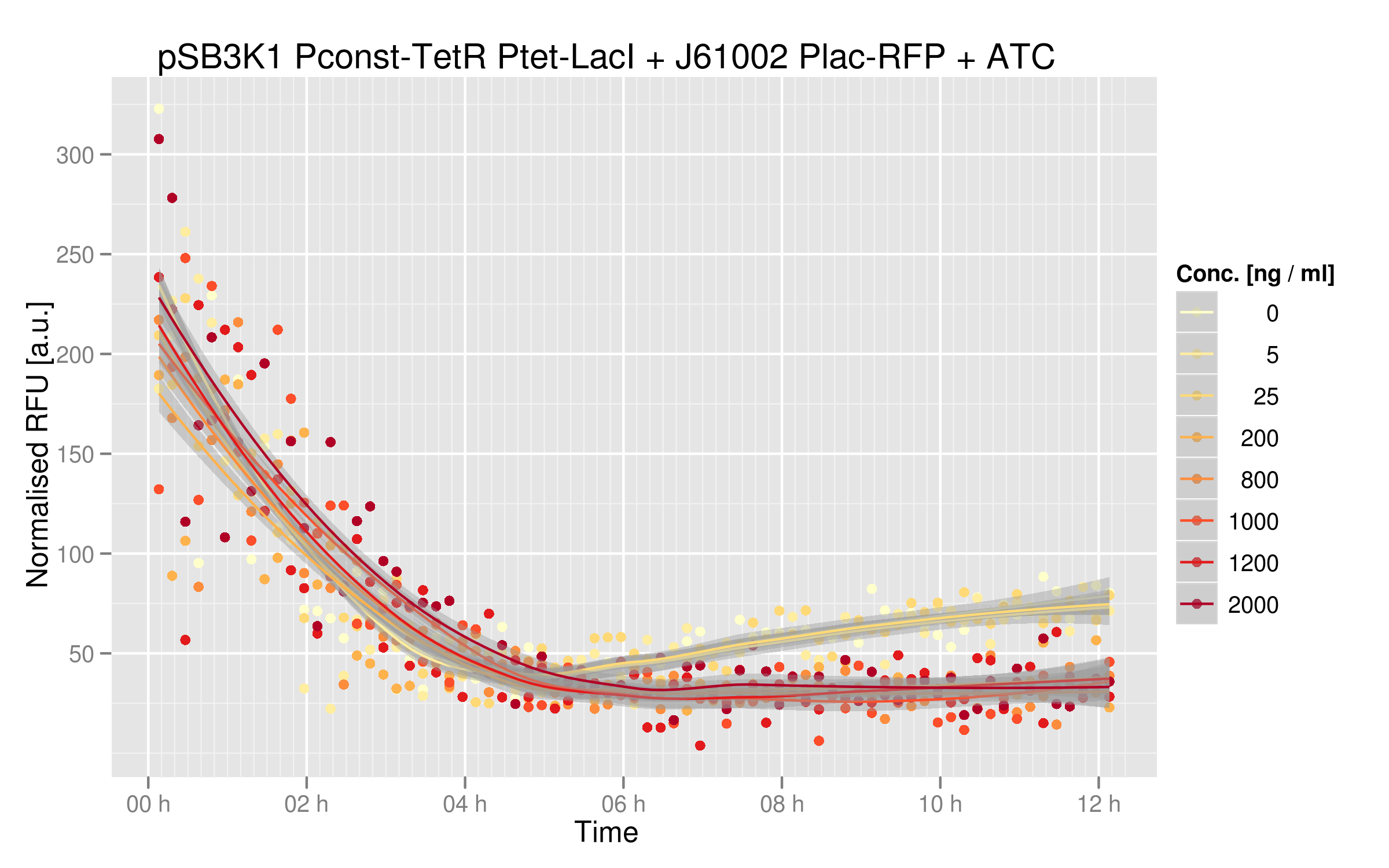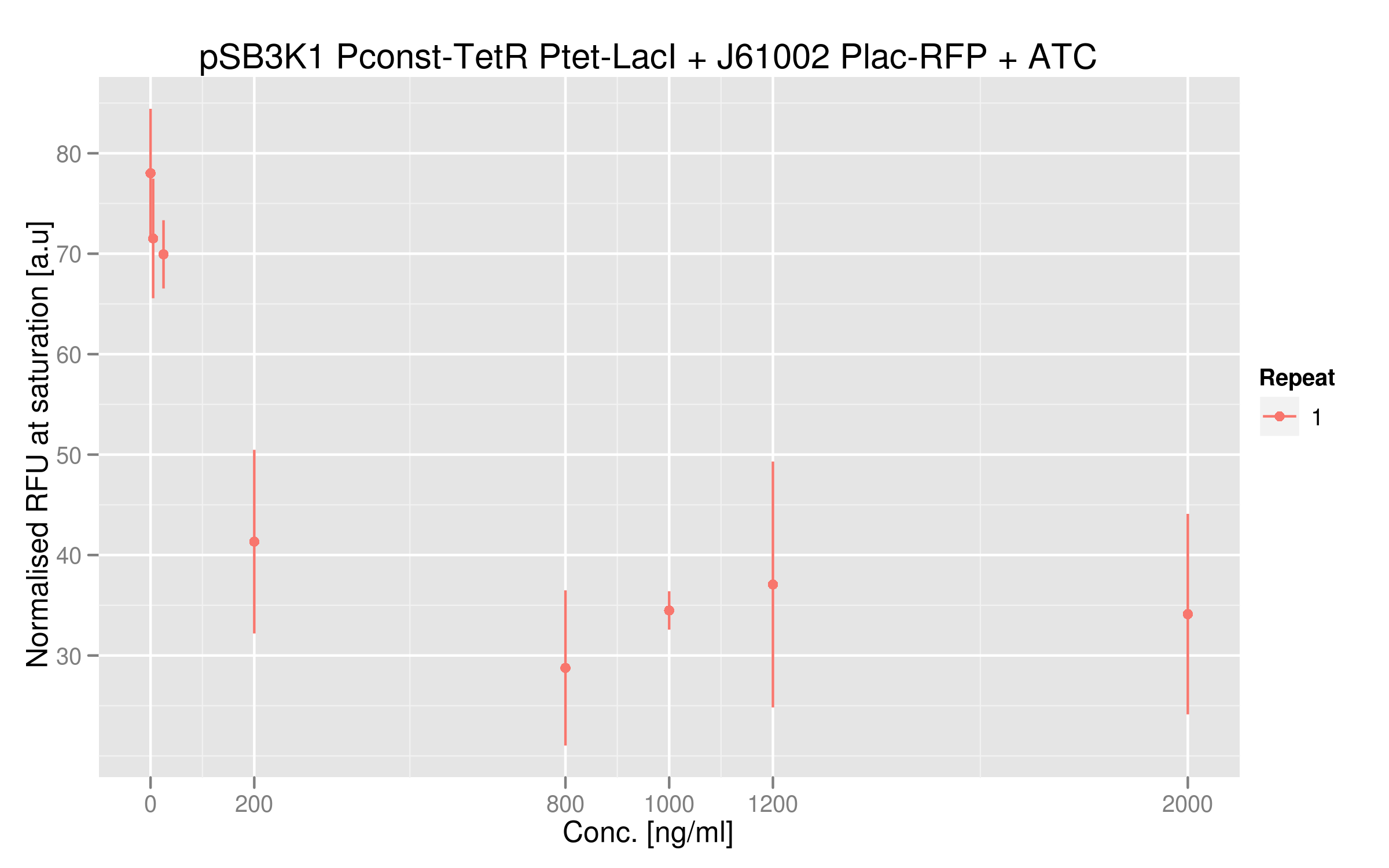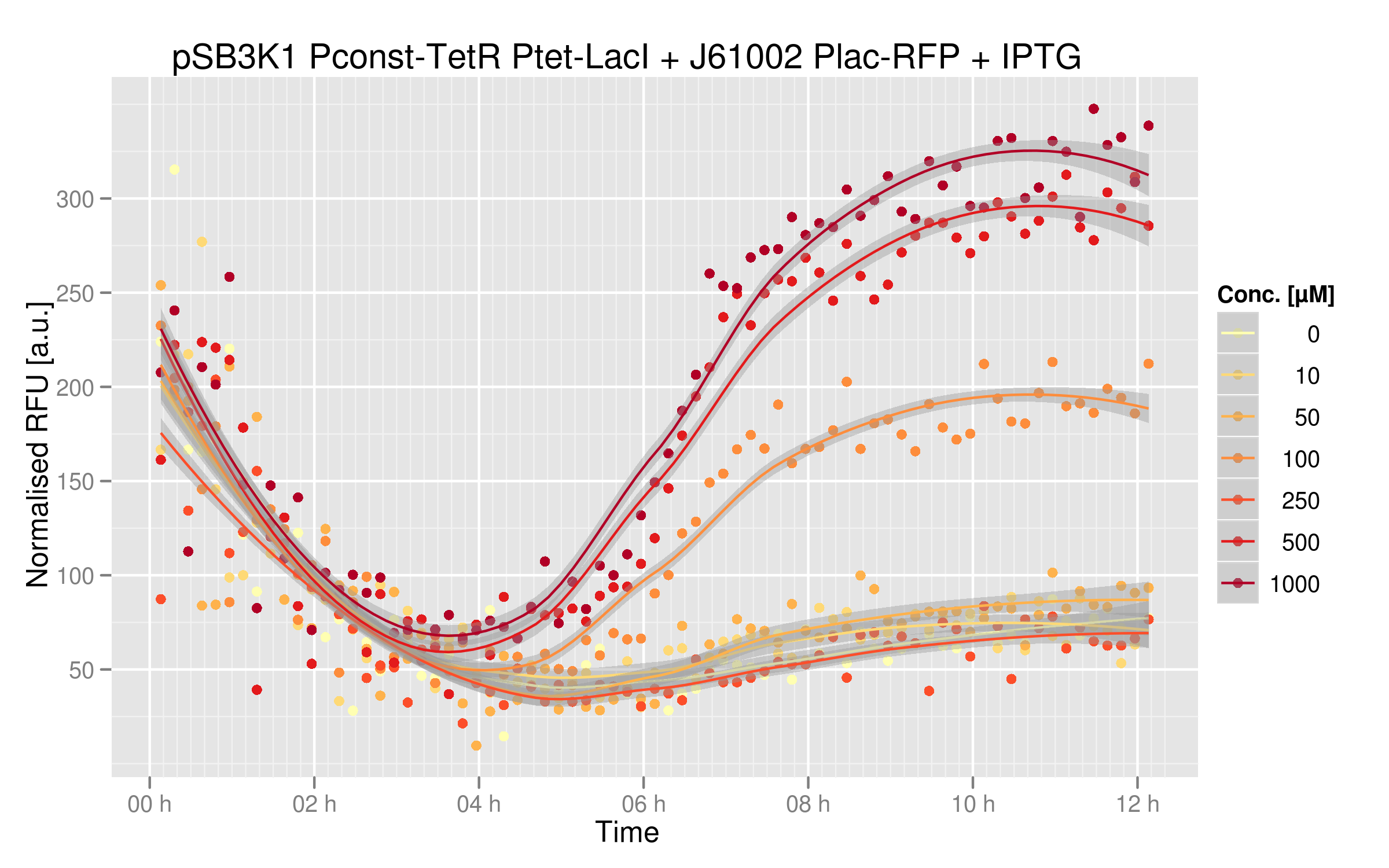Team:EPF-Lausanne/Our Project/Assembly
From 2011.igem.org
| Line 1: | Line 1: | ||
{{:Team:EPF-Lausanne/Templates/Header|title=Reporter systems}} | {{:Team:EPF-Lausanne/Templates/Header|title=Reporter systems}} | ||
| + | The last step of our overall strategy is to characterize ''in vivo'' the affinity and specificity of our TetR mutants. To that end, we set up two reporter systems based on RFP fluorescence. | ||
| - | |||
| - | |||
| - | |||
== TetR-RFP system == | == TetR-RFP system == | ||
| - | The first system is the simplest one; it is composed of TetR driven by a constitutive promoter and of RFP under Ptet control. If TetR '''binds''' to Ptet, then RFP is ''' repressed'''. | + | === Description === |
| + | |||
| + | The first system is the simplest one; it is composed of TetR driven by a constitutive promoter and of RFP under Ptet control. If TetR '''binds''' to Ptet, then RFP is ''' repressed'''. By applying different concentrations of ATC to the cells, RFP is getting expressed - the strongest the TetR mutant is bnding to Ptet, the highest ATC cncentration you need to have full expression of RFP. | ||
| + | |||
| + | [[File:EPFL_Summary_without_LacI.jpg]] | ||
| + | |||
| + | |||
| + | The TetR and RFP genes were put on two different plasmids: pSB3K1 pConst-TetR and J61002 Ptet-RFP. For more details about them, please refer to the [add link once the new page has been created] page. | ||
| + | |||
| + | add image | ||
| + | |||
| + | |||
| + | |||
| + | === Experimental validation - with wild-type TetR === | ||
| + | |||
| + | |||
| + | ''ATC induction'' | ||
| + | |||
| + | |||
| + | To validate our first readout system, we performed platereader experiments with different concentrations of anhydritetracycline (ATC). This molecule binds to the TetR dimers and induces conformational changes that make the transcription factor unable to bind to Ptet. As a result, RFP can be expressed. | ||
| + | |||
| + | make and add graphs | ||
| + | |||
| + | |||
| + | |||
| + | Here are the results of our ATC induction experiment: | ||
| + | |||
| + | |||
| + | [[File:EPFL_Nadine-exp3-induction.png|600px]] | ||
| + | |||
| + | The induction curves show that RFP indeed increases with addition of TetR. Without any ATC in the medium, cells express about 2500 normalized RFUs when they reach a plateau, whereas with the highest values of ATC we have 25'000 normalized RFUs. There is a 10x difference between normal medium and addition of ATC, showing that our first readout system is effectively powerful: TetR mutants that would not recognize the consensus Ptet sequence would yield a lot more RFP expression than other mutants recognizing Ptet. | ||
| + | |||
| + | |||
| + | ''Dose-response'' | ||
| + | |||
| + | [[File:EPFL_Nadine-exp3-doseresponse.png|600px]] | ||
| + | |||
| + | By looking at the dose-response graph, we can see a significant increase between 0 and 200 ng/microL ATC; then the RFUs are quite stable. The graph shows that the TetR-Ptet interaction has a strong impact on RFP expression. The highest RFUs measured here correspond to the levels of the Ptet-RFP construct alone (without the TetR plasmid), showing that we can get a complete TetR inactivation in our experiment. | ||
| + | |||
| + | add link to Ptet-RFP characterization page | ||
| + | |||
| + | |||
| + | === TetR mutants characterization === | ||
| + | |||
| + | add platereader results asap | ||
| + | |||
| + | |||
| + | == TetR - LacI -RFP system == | ||
| + | |||
| + | === Description === | ||
| + | |||
| + | Our second system contains LacI in addition to TetR and RFP. TetR is still induced by a constitutive promoter, then LacI is under Ptet regulation and RFP is under Plac regulation. LacI plays here the role of an inverter, so that we can measure directly TetR-Ptet interactions: if TetR binds to Ptet, LacI is not expressed, so RFP is not repressed and is instead expressed. Here, the strongest a TetR mutant binds to Ptet, the highest RFP intensity we will get. | ||
| + | |||
| + | |||
| + | [[File:EPFL_Summary_TetR_LacI_RFP.jpg|700px]] | ||
| + | |||
| + | Here also we have a two-plasmid system; TetR and LacI are placed on the pSB3K1 Pconst-TetR Ptet-LacI plasmid whereas RFP is on the J61002 Plac-RFP plasmid. You can find more informations about these plasmids on the following page | ||
| + | add link once created | ||
| + | |||
| + | |||
| + | === Experimental validation - with wild-type TetR === | ||
| + | |||
| + | Our second readout system being based on TetR and LacI, we repressed both sequentially by using respectively ATC and IPTG. | ||
| + | |||
| + | ''ATC induction'' | ||
| + | |||
| + | Adding ATC in the medium of the co-transformed cells will inactivate TetR. As a consequence, LacI will be '''expressed''' and RFP will be '''repressed'''. We should then see a decrease of RFUs correlating with increasing concentrations of ATC. | ||
| + | add image | ||
| + | |||
| + | [[File:EPFL_Nadine-exp4-induction.png|600px]] | ||
| + | |||
| + | With no or low concentrations of IPTG in the cells' medium, RFP expression is quite weak; this can be explained by the fact that Ptet was mutated in our plasmids and thus TetR couldn't repress LacI very efficiently. In normal conditions, we should see RFP expression when TetR binds to Ptet - which is the case here, since we have the wild-type TetR gene. Here, LacI not well repressed by TetR, thus RFP is repressed even when TetR binds to Ptet. | ||
| + | Nevertheless, there is a decrease in RFP expression when we add sufficient amounts of ATC. Even in our mutated system, TetR interaction to Ptet still has an effect on the output. There is a 2-fold difference between high ATC concentrations and no ATC; we believe that, by restoring Ptet sequence, this difference would be higher. | ||
| + | |||
| + | ''ATC dose-response curve'' | ||
| + | |||
| + | [[File:EPFL_Nadine-exp4-doseresponse.png|600px]] | ||
| + | |||
| + | This data shows more clearly the difference of normalized RFUs for low or high concentrations of ATC - even if the intensities are low. As in our first readout system, the highest ATC efficiency seems to be reached with 200 ng/microL already. | ||
| + | |||
| + | |||
| + | ''IPTG induction'' | ||
| + | |||
| + | IPTG will inactivate LacI, so that RFP will be more '''expressed'''. The expected results are an increase of RFUs in parallel of an increase of IPTG concentration in the medium. | ||
| + | add image | ||
| + | |||
| + | [[File:EPFL_Nadine-exp5-induction.png|600px]] | ||
| + | |||
| + | Indeed,RFUs increase 8-fold between no IPTG and the highest concentrations. Note that the RFU intensity for the curve with no IPTG match the intensity of the curve with no ATC in the ATC induction experiment, showing that these two experiments are consistent. The curves with the highest IPTG concentrations are not overlapping, showing that perhaps we could repress LacI in a more efficient manner if we used higher IPTG concentrations. | ||
| + | |||
| + | |||
| + | ''IPTG dose-response curve'' | ||
| + | [[File:EPFL_Nadine-exp5-doseresponse.png|600px]] | ||
| + | add explanations | ||
{{:Team:EPF-Lausanne/Templates/Footer}} | {{:Team:EPF-Lausanne/Templates/Footer}} | ||
Revision as of 16:48, 19 September 2011
Reporter systems
The last step of our overall strategy is to characterize in vivo the affinity and specificity of our TetR mutants. To that end, we set up two reporter systems based on RFP fluorescence.
Contents |
TetR-RFP system
Description
The first system is the simplest one; it is composed of TetR driven by a constitutive promoter and of RFP under Ptet control. If TetR binds to Ptet, then RFP is repressed. By applying different concentrations of ATC to the cells, RFP is getting expressed - the strongest the TetR mutant is bnding to Ptet, the highest ATC cncentration you need to have full expression of RFP.
The TetR and RFP genes were put on two different plasmids: pSB3K1 pConst-TetR and J61002 Ptet-RFP. For more details about them, please refer to the [add link once the new page has been created] page.
add image
Experimental validation - with wild-type TetR
ATC induction
To validate our first readout system, we performed platereader experiments with different concentrations of anhydritetracycline (ATC). This molecule binds to the TetR dimers and induces conformational changes that make the transcription factor unable to bind to Ptet. As a result, RFP can be expressed.
make and add graphs
Here are the results of our ATC induction experiment:
The induction curves show that RFP indeed increases with addition of TetR. Without any ATC in the medium, cells express about 2500 normalized RFUs when they reach a plateau, whereas with the highest values of ATC we have 25'000 normalized RFUs. There is a 10x difference between normal medium and addition of ATC, showing that our first readout system is effectively powerful: TetR mutants that would not recognize the consensus Ptet sequence would yield a lot more RFP expression than other mutants recognizing Ptet.
Dose-response
By looking at the dose-response graph, we can see a significant increase between 0 and 200 ng/microL ATC; then the RFUs are quite stable. The graph shows that the TetR-Ptet interaction has a strong impact on RFP expression. The highest RFUs measured here correspond to the levels of the Ptet-RFP construct alone (without the TetR plasmid), showing that we can get a complete TetR inactivation in our experiment.
add link to Ptet-RFP characterization page
TetR mutants characterization
add platereader results asap
TetR - LacI -RFP system
Description
Our second system contains LacI in addition to TetR and RFP. TetR is still induced by a constitutive promoter, then LacI is under Ptet regulation and RFP is under Plac regulation. LacI plays here the role of an inverter, so that we can measure directly TetR-Ptet interactions: if TetR binds to Ptet, LacI is not expressed, so RFP is not repressed and is instead expressed. Here, the strongest a TetR mutant binds to Ptet, the highest RFP intensity we will get.
Here also we have a two-plasmid system; TetR and LacI are placed on the pSB3K1 Pconst-TetR Ptet-LacI plasmid whereas RFP is on the J61002 Plac-RFP plasmid. You can find more informations about these plasmids on the following page
add link once created
Experimental validation - with wild-type TetR
Our second readout system being based on TetR and LacI, we repressed both sequentially by using respectively ATC and IPTG.
ATC induction
Adding ATC in the medium of the co-transformed cells will inactivate TetR. As a consequence, LacI will be expressed and RFP will be repressed. We should then see a decrease of RFUs correlating with increasing concentrations of ATC.
add image
With no or low concentrations of IPTG in the cells' medium, RFP expression is quite weak; this can be explained by the fact that Ptet was mutated in our plasmids and thus TetR couldn't repress LacI very efficiently. In normal conditions, we should see RFP expression when TetR binds to Ptet - which is the case here, since we have the wild-type TetR gene. Here, LacI not well repressed by TetR, thus RFP is repressed even when TetR binds to Ptet. Nevertheless, there is a decrease in RFP expression when we add sufficient amounts of ATC. Even in our mutated system, TetR interaction to Ptet still has an effect on the output. There is a 2-fold difference between high ATC concentrations and no ATC; we believe that, by restoring Ptet sequence, this difference would be higher.
ATC dose-response curve
This data shows more clearly the difference of normalized RFUs for low or high concentrations of ATC - even if the intensities are low. As in our first readout system, the highest ATC efficiency seems to be reached with 200 ng/microL already.
IPTG induction
IPTG will inactivate LacI, so that RFP will be more expressed. The expected results are an increase of RFUs in parallel of an increase of IPTG concentration in the medium.
add image
Indeed,RFUs increase 8-fold between no IPTG and the highest concentrations. Note that the RFU intensity for the curve with no IPTG match the intensity of the curve with no ATC in the ATC induction experiment, showing that these two experiments are consistent. The curves with the highest IPTG concentrations are not overlapping, showing that perhaps we could repress LacI in a more efficient manner if we used higher IPTG concentrations.
IPTG dose-response curve
add explanations
 "
"







